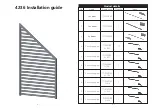
13
must be discontinued immediately. If the slightest
doubt remains, the product must be retired or may
not be used again until a duly compentent person,
having subjected such product to the required te-
sting and inspections, has approved its further use
in writing.
It must be ensured that the recommendations for
use with other components
be met: Further PPE
components must meet the harmonized standards
under the regime of regulation (EU) 2016/425. By
combining pieces of equipment in a way that will
compromise the safe functioning of one of these
pieces of equipment or of the combination as a
whole, you will be putting yourself in danger!
Ensure all neighbouring components are compati-
ble. Ensure all components are correctly configured.
Failure to do so increases risk of serious injury or
fatality. It is the responsibility of the user that a re-
levant and ‘live’ Risk Assessment is in place for the
work to be carried out which includes emergency
contingencies.
A
plan of rescue measures
that covers all fore-
seeable emergencies needs to be in place before
this product can be used. Prior to and during use,
rescue measures that can be executed safely
and effectively must be considered at all times.
SUSPENSION TRAUMA
(HARNESS HANG SYNDROME)
Remaining suspended motionless in a harness for
longer periods of time (e.g., after having fainted)
may cause one’s blood circulation to be restricted
and consequently lead to a so-called "suspension
trauma". MORTAL DANGER! Make an EMERGENCY
CALL immediately!
Possible signs of a suspension trauma are pallor,
sweating, shortness of breath, impaired vision,
dizziness, nausea. (incomplete list, symptoms may
vary greatly from one person to another). Therefore,
affected persons should, if he/she is still able to
do that, take suitable self-help measures in order
to prevent blood congestion in the legs (e.g., by
moving the legs or taking the load off the leg loops,
e.g. by putting the feet in foot loops).
If this is not possible, it will be crucial to rescue the
person from the suspended position as fast as pos-
sible and provide the necessary emergency medical
care.
CAUTION! DO NOT PLACE THE PERSON IN A SU-
PINE OR SHOCK POSITION IMMEDIATELY -> MOR-
TAL DANGER!
Place the accident victim either in a sitting or a
squatting position or, if the person is unconscious,
in a stable side position, if possible with the upper
body elevated (avoidance of heart failure due to
overly fast reflow of blood from the lower half of the
body).
TRANSPORT, STORAGE & CLEANING
The textile materials of our products consist of PA
or PES. The fitting parts consist of aluminum and
steel. The heat load must therefore never exceed
100°C. Chemicals may attack the material and cau-
se it to lose in strength. In case of reactions such
as discoloration or hardening, the product must be
retired for safety's sake.
The products much always be
transported
in
suitable packaging (protected from dirt, moisture,
chemicals, UV radiation, mechanical damage, etc.).
Conditions of storage:
�
Protected from light (UV radiation, welding
machines …)
�
dry and clean
�
at room temperature
�
Not in the proximity of chemicals (acids, lyes,
liquids, vapours, gases, …) and other
aggressive environments
�
Protected against sharp-edged objects
For
cleaning
, use lukewarm water and mild-action
detergents. Then, rinse the equipment with clear
water and dry it prior to putting it into storage. Dry
the product in a natural way, not near fires or other
heat sources.
For
disinfection
, use only substances that do not
have an impact on the synthetic material and metals
used.
If you fail to observe these provisions, you will be
putting yourself into danger!
REGULAR CHECKS
Checking the equipment at regular intervals is
ab-
solutely necessary:
your safety depends on the
effectiveness and durability of the equipment!
Prior to and after any use,
the equipment should
SECURITY / TRANSPORT, STORAGE &
CLEANING / REGULAR CHECKS














































